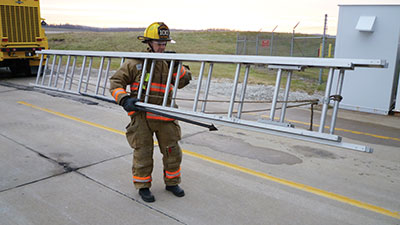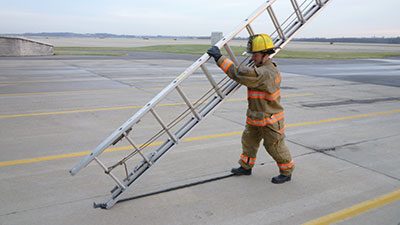
Features
Training
Tim-Bits: January 2014
In October, we looked at the most effective and efficient way for one firefighter to carry and raise a ladder.
January 7, 2014
By Tim Llewellyn
In October, we looked at the most effective and efficient way for one firefighter to carry and raise a ladder. Firefighters should know how to modify this technique for different types of structures or situations.
As the firefighter approaches a building, he raises the ladder horizontally from his body and places the spurs into the ground-wall corner of the building to securely foot the ladder as it is raised. This technique works great for situations in which a ladder is being raised to a window or a flush balcony. It does not work well when the ladder needs to be put to a roof with a long eave; this would cause the ladder to lean excessively outward, creating an unsafe situation as the ladder is raised to the target. A similar situation would occur if the ladder was raised to an extended balcony or porch.
Modifying the technique involves the footing of the ladder: if the building’s structural features are not helpful, the firefighter must overcome the challenge while relying on basic skills learned in recruit school.
 |
|
| Photo 1: A secondary hand tool, such as a pike pole or a steel roof hook, can help you to raise a ladder to a roof with a long eave, for example. Photos by Tim Llewellyn |
|
 |
|
| Photo 2: Hold the hook end of the pike pole or roof hook on the spot where you want to ground the ladder. Hold the tool in place with your foot and secure the spur of the ladder in the hook of the tool. Advertisement
|
Today’s firefighters have been told repeatedly not to go anywhere on the fire ground without a hand tool (or two) that can help in their mission: here, the ladder is the primary tool. A short pike pole (or steel roof hook) would be a logical secondary tool that could be carried with the ladder along the outside of the upper or lower beam, or hooked to a rung and carried against the body on the inside of the ladder, freeing the hands (see photo 1).
Not only can this tool help with window ventilation, forcible entry and many other fire-ground tasks associated with laddering, it also can be used to help raise a ladder. As the firefighter approaches the balcony, he picks an approximate spot on the ground where the ladder will most likely stand at a safe climbing angle, and places the tool with the hook end on that spot. The shaft of the tool should lie in the direction that the firefighter will travel. The firefighter then places the weight of one foot on the shaft end of the tool to hold it in place and secures the spur of the ladder in the hook of the tool on the ground (see photo 2). By concurrently raising the ladder and walking along the tool, the single firefighter is able to beam raise the ladder to the balcony. This technique works especially well when the ground surface is a seamless concrete pad, such as a sidewalk or patio. It has been adopted as a tactic for use by the aircraft rescue and firefighting (ARFF) industry for situations in which a tall aircraft must be boarded by emergency personnel on the runway or taxiway.
If the firefighter does not carry a pike pole or roof hook, a Haligan bar or axe could be used, but only if the ground surface is made of soil or gravel. Instead of walking along the tool to secure it, the firefighter would bury the head of the axe or the adz of the Haligan bar into the ground and use the end of the handle closest to the buried part as the footing assist.
It is also possible for a single firefighter to extend a ladder that has been raised in this manner. With the ladder upright and balanced, the firefighter stands at the beam of the ladder and places the instep of his outside foot diagonally against the spur on the fly side of the base section of the ladder. The firefighter then twists toward the building and around the ladder, placing the back of his shoulder against the halyard side of the ladder’s bed section. This manoeuvre will place a firm hold on one beam of the ladder and hold it upright in place while the firefighter pulls on the halyard to extend the ladder to the destination. Once the ladder is placed, it should be checked for a proper climbing angle prior to climbing.
Fire-ground skills need to be practised constantly, especially those that deviate from what we learned in our pre-service
days.
A fire-service veteran since 1989, Tim Llewellyn is a firefighter for the Allegheny County Airport Authority in Pittsburgh, Penn. He volunteers for the Adams Area Fire District in Pennsylvania and is an instructor for the PA State Fire Academy, the Allegheny County Fire Academy and the Pittsburgh International Airport fire training facility. E-mail him at llewllyn.fire@gmail.com
Print this page